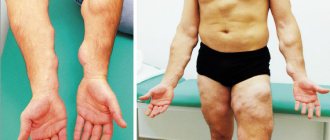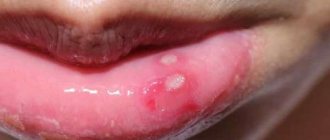A bump on the face is always unpleasant and not very aesthetically pleasing. Read the article for what to do.
Lumps or lumps on the body can either be painful or painless. They can also have different localizations on the body: on the head, face, limbs, back, neck, and groin area.
Read another article on our website on the topic: “Sick, large lump on the top, bottom of the foot . You will learn why it appeared, what types there are, which doctor to contact, what diagnosis is prescribed, and how to treat it.
The appearance of a lump can be associated both with mechanical damage to the skin, for example, after an injury or bruise, and with a violation of metabolic processes in the body; it can also be associated with the transition of a chronic disease to an acute form. It is especially unpleasant when bumps appear on the face. This article describes the causes of such a neoplasm, as well as how to treat it. Read on.
Why do bumps appear on the face: reasons
Lumps on the face
If any lump is detected, you should immediately consult a doctor to rule out malignant neoplasms. With early diagnosis of any pathology, treatment will be much easier.
Signs that indicate you need to see a doctor:
- Deterioration of condition
- Hyperthermia
- Painful sensations
- Inflammation of the skin
- Intoxication of the body
Why do bumps appear on the face? There are a number of reasons why compactions occur:
- Hemangioma
- Increased secretion of sebaceous glands
- Skin fibroma
- Infectious disease
- Papilloma
- Birthmarks
- Skin fibroma
You should also know about the types of such seals. Read on.
Symptoms of cheek cancer
Cheek cancer in the initial stages of the tumor process is asymptomatic. Any ulcer that is not prone to rapid healing and any area of hyperkeratosis should be regarded as an early stage of cancer. In the early stages of cheek malignancy, there is little or no pain. As the size of the cancer tumor increases, the following symptoms appear:
- Pain;
- Induration and infiltration of underlying tissues;
- Enlargement of regional lymph nodes, including damage to the lymph nodes of the submandibular triangle, jugular-digastric group and deep cervical lymph nodes.
What does cheek cancer look like? Any non-healing oral mucosal ulcer should be assessed as a potentially malignant tumor and consultation with an oncologist should be sought.
Types of bumps on the face and neck
The doctor can almost always determine the type of lump - visually or by touch. Sometimes a more in-depth diagnosis may be needed. There are several common types of bumps on the face and neck:
- Lipomas
- Hygromas
- Atheromas
- Enlarged lymph nodes
- Prosyanka
- Abscess
- Hernia
- Malignant neoplasms
Let's take a closer look at each type:
Lipoma - a lump on the face
- Lipomas
Lipomas are most common in cosmetology and medicine. People call them wen. These are benign neoplasms that originate from adipose tissue. There are both individually growing and entire colonies. People with diabetes, pathologies of the liver, pancreas, urinary system, hormonal disorders, as well as people with alcohol addiction often suffer from lipomas. It is possible that lipoma is inherited, that is, it is fixed genetically.
Most often, lipoma appears in women aged 30 to 40 years. Hard subcutaneous balls that do not cause pain, but can grow.
Hygroma - a lump on the face
- Hygromas
Such seals are also called synovial cysts. This is a benign neoplasm that is filled with serous-mucous or serous-fibrous fluid. This seal can occur after an injury, due to a genetic factor, or as a complication after surgery on the hand.
Again, hygroma develops 3 times than in men. Hygroma can be painful; it can be either sharp or dull pain. However, in almost half of the cases this thickening does not cause pain.
Atheroma - a lump on the face
- Atheromas
This benign neoplasm, which has a round shape, consists of a capsule containing a white-yellow liquid. Atheroma develops in rare cases; it is diagnosed in 5-10% of people.
Atheromas can be both true and false. True ones originate in microparticles of the epidermis of the skin with a genetic predisposition, and false ones are formed at the site of blockage of the sebaceous ducts of the gland, where secretions accumulate. This neoplasm can occur in people with impaired metabolism in the body, in harmful environmental conditions, or in hormonal imbalances.
Enlarged lymph nodes - bump on the face
- Enlarged lymph nodes
Enlarged lymph nodes of various locations may indicate the presence of an infectious process in the body. A wound or scratch may be found near the enlarged lymph node. If after treatment the lymph node has not decreased, but on the contrary there is pain, then you should consult a specialist.
Prosyanka - bumps on the face
- Prosyanka
This is a benign neoplasm, which is characterized by the appearance of many small white lumps on the skin. They can be both local and widespread. A common cause is the retention of sebaceous gland secretions due to improper skin care. Millet rash can occur even in newborn babies, but after a while they go away on their own without leaving a trace.
Abscess - lump on the face
- Abscess
It is painful, has redness, local hyperthermia, and inflammation of the skin area. The reasons are injuries, impacts, any mechanical damage, injections. If there is an abscess, you should immediately contact a specialist so that the source of inflammation does not progress.
Hernia - a lump on the face
- Hernia
This neoplasm causes discomfort due to pain, and nausea and vomiting may also occur. A hernia can develop in the navel, groin, thighs and other places. There are many reasons for the development, the most common of which are: pregnancy and childbirth, constipation, mechanical damage, heavy lifting, lung diseases, injuries to the musculoskeletal system, including the spine.
Melanoma - a bump on the face
- Malignant tumors
These are the most insidious neoplasms, since they are asymptomatic for a long time. And symptoms appear only in the later stages, when the tumor reaches a large size. Urgent consultation with a specialist and surgical intervention are required.
The danger of atheroma on the face
Sebum and keratin masses accumulated in the atheroma capsule have a cheesy consistency. This is a favorable environment for the development of bacteria. An attempt to squeeze out the atheroma can lead to infection getting inside the capsule and causing suppuration. The main symptoms of its onset are:
- redness of the skin around the atheroma;
- pain in the affected area;
- Migraine-like headaches;
- temperature increase.
Inflamed atheroma can lead to phlegmon - inflammation of adjacent tissues without precise boundaries.
Rice. 3 Self-squeezing of atheroma usually leads to inflammation of facial tissues
Lump on the face after a blow: what is it, reasons
A lump, or otherwise hematoma, appears after a blow if the integrity of the blood vessels located in the subcutaneous tissue is disrupted. As a result, blood flows out, forming swelling and redness. This is the main reason.
The lump causes discomfort, in addition to the fact that it causes pain, it is also an aesthetic defect on the face. It is necessary to immediately apply a cold object, such as ice, to the site of impact, as cold accelerates blood clotting. You can hold it for 10-15 minutes - no longer to avoid frostbite of the skin.
White bump on the face: what is it, reasons
Perhaps you have ever noticed tiny white bumps on your face, which are most often found in the area of the eyes, nose, and cheeks. These seals are called milia. They are filled with keratin inside and appear without any reason, but the contributing factors or causes are:
- Rosacea disease
- Traumatization of the skin
- Sunburn
- Clogged enlarged pores
Milia are not harmful to the body because they are made up of dead epidermal cells located under the skin. But they are an aesthetic defect that can be easily eliminated with the help of a cosmetologist.
Purulent bumps on the face: what is it?
Inflamed pimples are purulent bumps on the face with a white head, sometimes they are painful; serous secretions can accumulate in such heads. Pus occurs because, in response to bacteria that have entered a pore or wound in the skin of the face, the immune system begins to attack so that they do not penetrate deeper and spread throughout the body. The immune system begins to activate white blood cells that fight bacteria. This process is called phagocytosis. White blood cells devour bacteria and die themselves. Serous secretion is an accumulation of dead leukocytes.
Under no circumstances should a purulent pimple be squeezed out, as a scar or scar may remain on the delicate skin, and the infection can also enter the body back into the body. Wait until the pimple “ripens” itself and the pus comes out on its own. To speed up “ripening”, use drying ointments.
The mechanism of development of cheek cancer
Malignant tumors of the cheek occur against the background of precancerous changes in the epithelial and subepithelial layers (leukoplakia or erythroplakia). The risk of leukoplakia degenerating into invasive cheek cancer is about 4-6%, with erythroplakia it reaches 30%. Subsequently, dysplasia transforms into “cancer in situ”, which penetrates into surrounding tissues and metastasizes to local and regional lymph nodes.
In some patients, even those cells that do not initially raise suspicion of dysplasia upon initial microscopy may gradually become malignant. As the tumor process progresses, distant metastases occur in the bones, lungs, and liver. Buccal cancer can grow through the skin.
Swelling of the face with bumps
Swelling of the face with bumps
This could be angioedema or Quincke's edema - an allergic reaction when the skin swells, swells, and increases in size. The mucous membranes may also swell. Itching and burning occurs. This is an acute reaction of the body, which is associated with the work of mast cells; allergies can be caused by any factors:
- Food
- Poison
- Medicines
- Pollen, etc.
At the first symptoms of angioedema, you need to immediately call an ambulance, do not panic, provide an influx of fresh air, take antihistamines, try to eliminate the factor that caused the allergy:
- For pollen allergies - wash your face and nasal passages
- If an insect bites you, remove the sting
- If you have a dust allergy, go to a damp room or outside
Drinking plenty of alkaline fluid when your face is swollen with bumps will help speed up the removal of the allergen from the body. Apply a cold bandage to the swollen area to reduce swelling, wait for the ambulance to arrive.
Diagnostics: if a lump comes out, inflammation appears on the face
To diagnose a lipoma, a specialist conducts an interview in the form of a survey, then proceeds to examine and palpate the lesion. And also used:
- Ultrasound examination (ultrasound)
- Magnetic resonance imaging (MRI)
- Electroradiography (ERG)
- Computed tomography (CT)
They help to detect places of enlightenment that should not normally be there. What other types of diagnostics are used if a lump comes out or inflammation appears on the face?
Hygroma detection is facilitated by:
- Ultrasound examination (ultrasound)
- Radiography
- Taking a puncture from a hygroma
To differentiate the diagnosis of hygroma from a hernia, the specialist prescribes diaphanoscopy. Other methods are also used to diagnose skin tumors:
- MRI (magnetic resonance imaging)
- Ultrasound (ultrasound examination)
- Duplex scanning
- Computer topography of the spine
- Computer electroencephalography
- Check-up (comprehensive examination of the body)
Who should I contact if I notice problems on my face in the form of a lump? Read on.
Which doctor should I contact if a lump grows on my face?
If a lump grows on your face, you need to contact a therapist.
If you notice that a lump is growing on your face or some other new growth has appeared on the skin, first make an appointment with a therapist. When you contact this doctor, he will examine the lump and find out the reasons for its occurrence. Here are two outcomes:
- The doctor independently prescribes treatment if he is confident in the diagnosis and its treatment
- Refers you to the right specialist
Lumps on the face are examined by a radiologist, neurologist or chiropractor.
Lumps after acne on the face: how to get rid of them?
Bumps after acne on the face
It often happens that after inflamed acne, a scar or bump remains on the face. How to get rid of it? If it does not resolve for a long time, you need to contact a dermatologist who will select a set of hardware procedures:
- Micromassage with ultrasound , which will help clean pores, smooth out wrinkles, improve blood circulation, even out facial tone and remove acne formations.
- Chemical peeling is done in a course. Excellent for removing the top layers of skin. Peeling can be superficial, medium and deep. The dermatologist himself will select the appropriate option.
- Laser dermabrasion is a very effective method, indicated for advanced cases when other methods cannot cope with aesthetic defects of the face.
The doctor may also prescribe some cleansing creams or ointments, traditional medicine methods and other additional treatment options.
Treatment of facial atheroma
Getting rid of atheroma using traditional methods of treatment, drugs of different release forms, or self-dissection is ineffective and dangerous . Atheroma can only be removed surgically along with the capsule. The smaller the formation, the easier the procedure will be and the greater the likelihood of being left without a scar on your face. Several methods of operating on atheroma on the face are practiced.
- Laser destruction of atheroma is the most effective and painless treatment method, after which there is no scar. Used to remove formations with a diameter of up to 5 mm.
- Laser excision of atheroma is an innovative treatment method that does not require a recovery period.
- The classic operation with a scalpel is the removal of atheroma. It is performed under local anesthesia.
During the inflammatory process, the doctor cleans out the contents and disinfects the atheroma cavity, then performs an operation to remove the capsule and, if necessary, the affected tissue. Even if the atheroma does not bother you and “does not spoil the beauty,” it still needs to be removed. Pressure on nearby tissues causes them to become deformed, and the possibility of inflammation puts your health at risk.
Preventing the formation of bumps on the face under the skin and on the skin
Prevention is of great importance when there is a risk of developing any of the pathologies. The same applies to the formation of bumps on the face under the skin and on the skin. To prevent seals from appearing, it is recommended:
- Monitor your diet
- Exercise moderately
- Control your weight
- Avoid skin injury
- Check your health every year
- Lead a healthy lifestyle
Take care of your health and undergo medical examinations in a timely manner. It is also important not to injure the skin, and if there is a genetic predisposition to the appearance of neoplasms on the face, you should consult a doctor at the first signs of pathology.
Wen on the body: reasons, how to get rid of it
A small growth on the skin, a pea-sized “nodule”, can cause anxiety and concern. Concerns increase if the formation begins to gradually increase in size. The specialist’s diagnosis of lipoma only adds fuel to the fire of worry, since it is very similar to the name of many dangerous malignant tumors.
In fact, there is no real reason for concern, since wen extremely rarely (almost never) degenerates into a malignant neoplasm. This is a benign tumor that is characterized by slow growth or stable size over a long period of time. Why wen appears on the body and how to deal with them, you will learn from the publication presented to your attention.
What is a wen?
Wen is an unofficial, “folk” name for a subcutaneous formation formed by adipose tissue. In official medicine, the scientific term “lipoma” is used, which reflects the histological composition of the tumor.
Lipoma is a benign tumor that remains as such throughout its existence. A wen on the body is not characterized by malignant degeneration. From this point of view, it does not pose a health threat. The problem is mainly of an aesthetic nature, especially if the tumor is located on an open area of the body - on the face, on the neck, on the skin of the distal parts of the arms.
A distinctive feature of any benign tumor is that it is formed from cells surrounded by a fibrous capsule. In this way, wen on the body differs from atheroma - another neoplasm, the appearance of which is caused by fat. Atheroma is an accumulation of sebum secreted by the sebaceous glands. Atheroma is formed due to blockage of the ducts of the sebaceous glands. The secretion of the gland cannot come out, accumulates under the skin and manifests itself in the form of a small or medium-sized formation that rises above the skin.
Lipoma, unlike atheroma, does not consist of the secretion of the sebaceous glands, but of fat cells surrounded by a capsule of connective tissue. A skin formation appears as a result of abnormally active division and growth of adipocytes. All cells, regardless of the size of the wen, remain differentiated, that is, they retain their typical characteristics, which makes it easy to distinguish a lipoma from a malignant tumor. A cancer tumor is characterized by impaired differentiation and atypical cell structure. In the case of lipoma, these signs of malignancy are not present.
Lipoma is a benign tumor of adipose tissue, which consists of differentiated adipocytes surrounded by a fibrous capsule. Malignant degeneration is not typical for wen on the body; they do not pose a danger to health or life.
Reasons for the appearance of wen
Numerous studies devoted to the problem discussed in the publication have not made it possible to establish a single cause of lipomas. Currently, it is generally accepted that a wen on the body appears as a result of the combined action of a number of predisposing factors, among which endogenous causes predominate.
Among the risk factors, the most important role is played by metabolic disorders associated with enzymatic deficiency. Particularly dangerous in this regard are disorders affecting the biochemical mechanisms of lipid and carbohydrate metabolism. The cause of lipoma can be hormonal disorders not related to the pathology of the endocrine system. In particular, in women, a neoplasm can appear during pregnancy, lactation or after the end of the lactation period.
Endocrine diseases are also among the risk factors. If a person has wen on the body, the reasons should be sought in the functioning of the hormonal system. Dysfunction of the pituitary, adrenal, thyroid (hypothyroidism) or pancreas (diabetes) may be the root of the problem. A risk factor is an imbalance in the secretion of sex hormones, which is important for women taking oral contraceptives and athletes using pharmacological agents to accelerate results.
A fatty deposit on the body can occur even against the background of complete well-being, that is, in the absence of any endocrine disorders, hormonal changes or metabolic problems. Doctors explain this by genetic predisposition: people whose relatives have encountered a similar problem have a higher risk of developing lipoma. Hereditary, or familial, lipomatosis is characterized by the appearance of multiple wen at a young age.
Among exogenous factors, nutrition is of greatest importance. The risk of lipoma is higher if a person's diet is dominated by simple carbohydrates (sugar, confectionery, flour), as well as saturated and hydrogenated fats. A risk factor is systematic alcohol consumption. All these substances interfere with the natural course of metabolic processes, which is fraught with the formation of a benign tumor of adipose tissue.
Another possible cause of the appearance of a wen on the body is mechanical trauma, which leads to neurotrophic disorders in the integumentary tissues. They, in turn, can provoke the proliferation of subcutaneous fat cells. It is possible that exposure to ultraviolet radiation on the skin plays a certain role, but the connection between this factor and the appearance of lipomas has not been proven.
Localization, appearance, symptoms
The concept of “typical localization” does not apply to wen on the body. The tumor can appear on any part of the body: on the back of the foot or hand, on the shoulder or forearm, on the back, on the chest, on the face or on the abdomen. In short, lipoma does not have a “favorite” location; the tumor can appear anywhere.
As for the symptoms, that is, the appearance of the tumor, there is more certainty. Externally, the lipoma looks like a pea; it is characterized by a rounded shape with regular and even edges. On palpation, the adipose tissue tumor is soft or moderately dense. The surface is smooth. The color can be flesh-colored, reddish or brownish, depending on how abundantly blood vessels grow into the tumor.
An important diagnostic criterion is the mobility of the tumor. The subcutaneous wen on the body is always mobile; it is not fused to deeper tissues and moves freely with the skin. This symptom makes it easy to distinguish a lipoma from a malignant tumor. The latter grows into deep tissues, which is why it becomes immobile.
Size is difficult to use as a diagnostic criterion because it can vary over a wide range. Typically, a fatty tissue tumor has a diameter of 0.5 to 1 cm, but there may be exceptions to this rule. Wen on the body can reach 2-3 cm in diameter. There are cases when, as a result of growth, a lipoma reached gigantic sizes - more than 10 cm in diameter.
The last symptom - pain - is not typical for wen. As a rule, education does not remind us of itself. The exception is situations when a person mechanically injures him. When struck, scratched or pinched, a sharp pain may occur, which is not too intense and passes quickly. However, if a tumor of adipose tissue puts pressure on superficial vessels and nerves, the clinical picture may include moderate or even severe pain.
Are wen dangerous?
As already mentioned, the prognosis for this benign tumor is extremely favorable. The neoplasm is not characterized by malignant degeneration, so nothing threatens life. However, this does not mean that you can forget about lipoma, since certain health risks are still present.
In case of mechanical damage (cut, pinching, blow) inflammatory processes may begin in the depths of the formation. If the integrity of the skin is damaged, there is a risk of infection in the wound. The result of this may be the development of a necrotic or purulent-inflammatory process, after treatment of which visible scars will remain on the skin.
Scars can also form after removal of a large tumor. A small lipoma can be removed without leaving a trace, so that there are no noticeable scars left on the skin. When removing large and giant wen, it is difficult to avoid scar changes. Meanwhile, large wen must be removed, since sooner or later they will begin to put pressure on the nerves and blood vessels. It follows from this that it is better to get rid of the wen at an early stage, before it grows to a large size, the only question is how to do this?
How to get rid of wen?
Many people, in an attempt to get rid of the tumor, resort to traditional medicine recipes. Numerous publications devoted to this problem offer various remedies: compresses made from onions, garlic or sprouted wheat, applications of celandine and other medicinal herbs. Unfortunately, such an approach is doomed to failure; it is not possible to get rid of education using folk remedies. Traditional recipes are unlikely to provoke the growth of a lipoma, but they certainly will not lead to a reduction in its size.
Official medicine offers two options for solving the problem. You can get rid of small lipomas using a minimally invasive procedure, which involves injecting a special solution deep into the formation that destroys adipocytes. The disadvantage of this method is that there is a high risk of relapse, the capsule is not removed, and the method can only be used for small (up to 2-3 cm) tumor sizes.
Surgical removal of a wen on the body is an effective and universal treatment method. The lipoma is removed along with the surrounding capsule. Minor surgery is performed using a traditional, radio wave or laser scalpel. Accordingly, traditional surgical, radio wave and laser removal are distinguished.
All methods of surgical treatment are effective, but from an aesthetic point of view they are not equivalent. After traditional surgical removal of a tumor, small scars often remain, even if the doctor removes a small tumor. Radio wave surgery allows you to minimize the severity of scars, and the laser method makes it possible to perform the operation absolutely without leaving a trace.
Laser lipoma removal has many benefits. The laser knife seals the vessels immediately after they are damaged, reduces bleeding, and injures the skin to a lesser extent. Since laser pulses have a detrimental effect on pathogenic and opportunistic microflora, there is no risk of infectious complications. In addition, the laser stimulates regeneration, which shortens the recovery period, accelerates skin healing and avoids scar formation.
The problem is that the laser method is used only for medium-sized and small-sized wen; large and gigantic ones (more than 10 cm in diameter) are forced to be removed by the doctor using the traditional surgical method. Given their size, it is almost impossible to avoid scar formation.
Since the aesthetic component of the operation is a concern for all patients, doctors recommend removing lipomas in the early stages. The deciding factor is the size of the education. A tumor on the face can be removed without a trace if its diameter does not exceed 1 centimeter. Wen on the body are removed without scarring if their size is no more than 2.5-3 cm.
Laser removal of wen is the most effective and safe method. It is better to remove lipomas in the early stages, when their size does not exceed 1 cm if localized on the face or 3 cm if localized on the body.
The operation is performed on an outpatient basis under local anesthesia; only giant lipomas require the use of general anesthesia (anesthesia). The patient returns home on the day of surgery. During the recovery period, it is necessary to protect the skin from ultraviolet rays and avoid exposure to high or low temperatures. It is advisable not to wet the wound with water and regularly treat it with antiseptic solutions.
Removal of fatty tissues on the body: price
Surgeries to remove fatty tissue are carried out in aesthetic medicine and plastic surgery clinics. It is advisable to contact a medical institution equipped with modern equipment for laser manipulation.
The price of removing wen with a laser is low.
The exact cost depends on the size of the education. The cost of removing a small lipoma (up to 3 cm) in Moscow clinics is about 5 thousand rubles. The cost of treating a tumor up to 10 cm in size increases to 8-9 thousand rubles. Treatment of large and giant lipomas costs more - up to 15 thousand rubles, depending on the size of the formation and the category of complexity of the operation. You will receive more detailed information about lipoma removal methods during a consultation with a doctor at the Galaktika aesthetic medicine clinic (Moscow)










